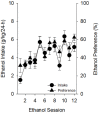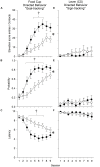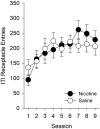Nicotine Enhances Goal-Tracking in Ethanol and Food Pavlovian Conditioned Approach Paradigms
- PMID: 34483813
- PMCID: PMC8416423
- DOI: 10.3389/fnins.2021.561766
Nicotine Enhances Goal-Tracking in Ethanol and Food Pavlovian Conditioned Approach Paradigms
Abstract
Rationale: Nicotine promotes alcohol intake through pharmacological and behavioral interactions. As an example of the latter, nicotine can facilitate approach toward food- and alcohol-associated stimuli ("sign-tracking") in lever-Pavlovian conditioned approach (PavCA) paradigms. However, we recently reported that nicotine can also enhance approach toward locations of reward delivery ("goal-tracking") triggered by ethanol-predictive stimuli when the location of ethanol delivery is non-static (i.e., a retractable sipper bottle).
Objective: To determine whether the non-static nature of the reward location could have biased the development of goal-tracking in our previous study (Loney et al., 2019); we assessed the effect of nicotine in a lever-PavCA paradigm wherein the location of ethanol delivery was static (i.e., a stationary liquid receptacle). Then, to determine whether nicotine's enhancement of goal-tracking is unique to ethanol-predictive stimuli, we assessed the effect of systemic nicotine on approach triggered by food-predictive stimuli in a lever-PavCA paradigm.
Methods: Long-Evans rats were used in two PavCA experiments wherein a lever predicted the receipt of ethanol (15% vol/vol; experiment 1) or food (experiment 2) into a stationary receptacle. Prior to testing, rats were administered nicotine (0.4 mg/kg subcutaneously) or saline systemically.
Results: In both experiments, nicotine increased measures of goal-tracking, but not sign-tracking.
Conclusion: Nicotine can facilitate approach to reward locations without facilitating approach to reward-predictive stimuli. As such, conceptualization of the mechanisms by which nicotine affects behavior must be expanded to explain an enhancement of goal-tracking by nicotine.
Keywords: alcohol; conditioned approach; cue-reactivity; goal-tracking; nicotine.
Copyright © 2021 Angelyn, Loney and Meyer.
Conflict of interest statement
The authors declare that the research was conducted in the absence of any commercial or financial relationships that could be construed as a potential conflict of interest.
Figures






References
-
- Bito-Onon J. J., Simms J. A., Chatterjee S., Holgate J., Bartlett S. E. (2011). Varenicline, a partial agonist at neuronal nicotinic acetylcholine receptors, reduces nicotine-induced increases in 20% ethanol operant self-administration in Sprague-Dawley rats. Addict. Biol. 16 440–449. 10.1111/j.1369-1600.2010.00309.x - DOI - PMC - PubMed
-
- Carter B. L., Tiffany S. T. (1999). Meta-analysis of cue-reactivity in addiction research. Addiction 94 327–340. - PubMed
Grants and funding
LinkOut - more resources
Full Text Sources
Research Materials

